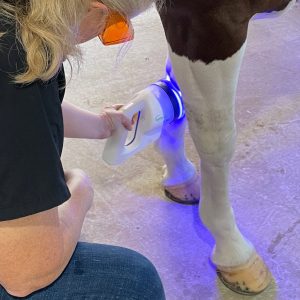Color Vision In the Horse
- Topics: Article, Other Eye Problems
A recent study by researchers at the Medical College of Wisconsin and the University of Wisconsin-Madison�s Schools of Medicine and Veterinary Medicine has shown that horses do possess color vision, albeit a reduced form compared to most people.
The cone cells responsible for color vision are arranged in a thin layer at the back of the eye (the retina). To have some form of color vision requires at least two different classes of cone cells, and that is the number found in the horse’s eye. One cone class in the horse absorbs light maximally in the short wavelengths (blue light), and one absorbs light in the middle to long wavelengths (green to red colors). They see even those colors differently than humans because the second cone class is not quite like human eye cones. Humans typically have three different cone cell types, and are thus called trichromatic, which literally means "three-colors." We now know that horses have dichromatic color vision ("two-colors"), although for many years it was believed that most common domestic animals are completely colorblind. Recently, it has been shown that many animals have color vision–for example, both dogs and cattle have been shown to have a similarly reduced form of color vision. In fact, there are even dichromatic humans.
|
||||||
Earlier studies that tested for color vision in horses demonstrated they had some ability to discriminate colors, and it was proposed that they might be dichromatic. The Wisconsin scientists used a non-invasive procedure to probe the electrical response of the cone cells to different wavelengths of light in the equine retina.
These new findings provide a very clear picture of how colors might appear to a horse. From the information about the horse’s cone cells, a computer algorithm was used to calculate how each color in a digital photograph would appear to a horse. Thus, for the first time, we can get an idea of how they might see the world. By comparing the image that simulates horse vision to the unaltered one, one can see which color distinctions a horse would make easily and which ones would be difficult
Create a free account with TheHorse.com to view this content.
TheHorse.com is home to thousands of free articles about horse health care. In order to access some of our exclusive free content, you must be signed into TheHorse.com.
Start your free account today!
Already have an account?
and continue reading.
Written by:
Joseph Carroll, Phd
Related Articles
Stay on top of the most recent Horse Health news with














